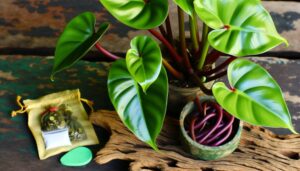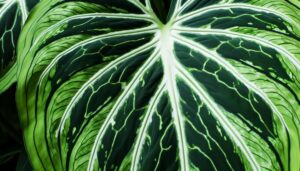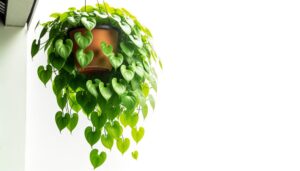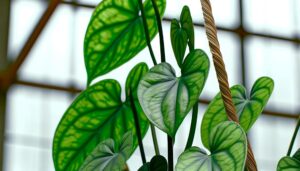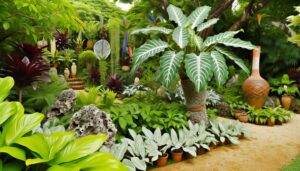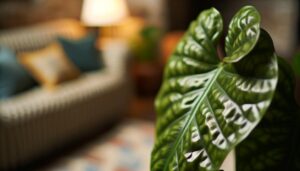What Is Philodendron Hederaceum Var Kirkbridei?
Philodendron hederaceum var. kirkbridei is a tropical plant native to Central and South America, classified under the Araceae family.
This variant is noted for its elongated, heart-shaped leaves and vining growth habit. Adapted to low light conditions, it utilizes aerial roots for moisture absorption.
Best growth requires a rich substrate comprising peat, perlite, and orchid bark. It thrives in humid environments with bright indirect light and balanced watering.
Common pests include aphids and spider mites, while root rot and bacterial leaf spot are potential diseases. This brief introduction only scratches the surface of its unique characteristics and care requirements.
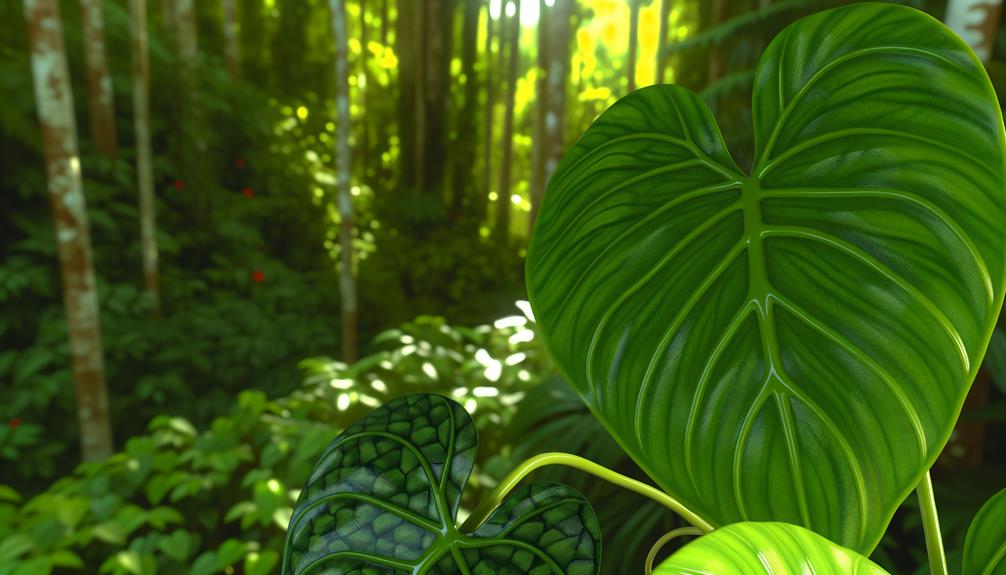
Key Takeaways
- Philodendron Hederaceum Var Kirkbridei originates from tropical rainforests in Central and South America.
- It features elongated, heart-shaped leaves and vining growth patterns.
- This plant thrives in humid, shaded environments with dappled sunlight.
- It adapts to low light conditions and uses aerial roots for moisture.
- Common pests include aphids, spider mites, and mealybugs, with diseases like bacterial leaf spot and root rot being threats.
Origins and History

Philodendron hederaceum var. kirkbridei, a subspecies of the Araceae family, originates primarily from the tropical rainforests of South America, where it thrives in the understory layer. This epiphytic and hemiepiphytic plant is adapted to low light conditions, utilizing its aerial roots to anchor onto tree trunks and absorb moisture from humid surroundings.
Indigenous to countries such as Brazil, Colombia, and Venezuela, it plays an essential role in the ecosystem by contributing to forest biodiversity. Historical records indicate its discovery by botanists exploring these biodiverse regions.
The plant's ability to colonize shaded, nutrient-poor environments has fascinated researchers, leading to extensive studies on its physiological adaptations and ecological significance in tropical forest ecosystems.
Botanical Classification
Philodendron hederaceum var. kirkbridei belongs to the Araceae family, which encompasses a diverse range of monocotyledonous flowering plants.
This particular variety exhibits distinctive morphological traits, such as elongated, heart-shaped leaves and vining growth patterns.
Indigenous to tropical regions of Central and South America, it thrives in humid, shaded environments.
Family and Genus
Belonging to the family Araceae, the genus Philodendron encompasses a diverse group of perennial plants characterized by their climbing growth habits and distinctive foliage.
The Araceae family, commonly known as the arum family, is renowned for its wide array of species exhibiting spadix-type inflorescences surrounded by a spathe. Within this family, the genus Philodendron stands out for its large, often lobed leaves and epiphytic or hemiepiphytic growth patterns.
Philodendron species typically thrive in tropical and subtropical regions, where they climb trees using aerial roots. The genus name, Philodendron, derives from Greek, meaning 'tree-loving,' indicative of their natural habitat.
Philodendron hederaceum var kirkbridei is a notable variety within this genus, requiring specific botanical classification for accurate identification.
Species Characteristics
Characterized by its heart-shaped leaves and vigorous climbing ability, Philodendron hederaceum var kirkbridei exhibits distinct morphological features that facilitate its accurate classification within the genus Philodendron.
This variety displays a robust climbing habit enabled by its aerial roots, which adhere to surfaces, promoting vertical growth. The leaves, typically dark green and glossy, exhibit a cordate shape with prominent venation, measuring approximately 10-15 cm in length. The petioles are elongated, supporting the lamina.
Philodendron hederaceum var kirkbridei belongs to the family Araceae, which is distinguished by inflorescences known as spadices surrounded by spathes. The taxonomic classification is reinforced by phylogenetic studies, emphasizing genetic markers that delineate its relationship within the Philodendron genus.
Native Habitat
Native to the tropical rainforests of Central and South America, Philodendron hederaceum var kirkbridei thrives in humid, shaded environments where it clings to tree trunks and other vertical surfaces. This epiphytic and occasionally hemiepiphytic species is particularly adapted to the understory of dense forests, where it benefits from high humidity levels and consistent moisture.
The plant's aerial roots enable it to absorb nutrients and water directly from the surrounding atmosphere and organic material on host trees. These conditions, characterized by dappled sunlight and rich organic matter, are vital for its growth and reproductive success.
Understanding these native habitat requirements is essential for horticulturists aiming to cultivate Philodendron hederaceum var kirkbridei in non-native settings.
Distinctive Features
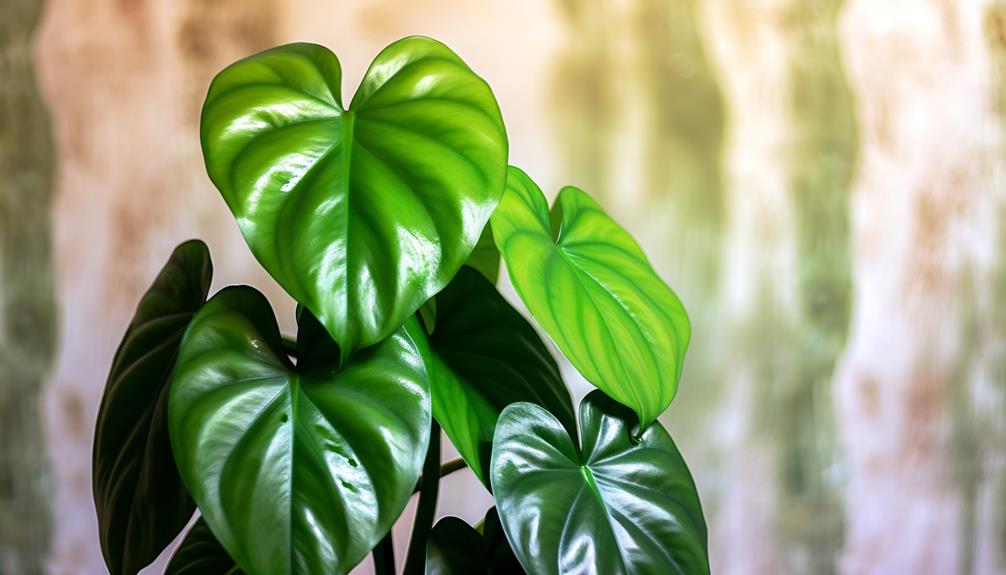
Philodendron hederaceum var. kirkbridei displays several distinct features, such as its elongated, heart-shaped leaves and prominent veining. The lamina can grow up to 30 cm long, showcasing a shiny, semi-glossy surface that enhances its decorative appeal.
Internodes have short lengths, adding to its compact growth pattern. The petioles, usually 10-20 cm in length, are sturdy and have a subtle sheath at their base for support. Aerial roots, another defining characteristic, abundantly emerge along the stem, aiding in nutrient absorption and stability.
Inflorescences are defined by a spadix surrounded by a spathe, although flowering is rare in indoor settings. These physical traits together highlight the distinctive botanical identity of Philodendron hederaceum var. kirkbridei.
Leaf Patterns and Colors
Particularly, the variegation in the leaves of Philodendron hederaceum var. kirkbridei is characterized by a spectrum of green hues, with intricate patterns that may include lighter green or yellowish streaks and spots.
The foliar surface exhibits a glossy texture, which accentuates the variegated patterns, enhancing their visual appeal. These patterns result from chlorophyll distribution discrepancies, a common phenomenon in variegated plants.
The leaf blades are typically heart-shaped (cordate) with a smooth margin, contributing to the plant's ornamental value. Additionally, the venation is pinnate, with prominent midribs and secondary veins that create a network-like structure.
The coloration and patterning can vary depending on light exposure, nutrient availability, and other environmental factors, making each specimen uniquely appealing.
Growth Habits
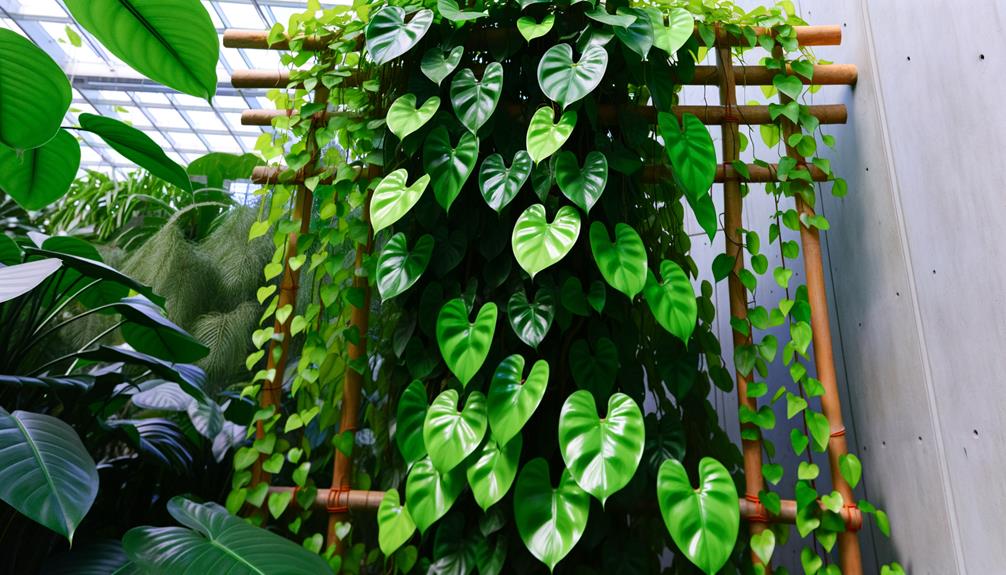
Philodendron hederaceum var. kirkbridei exhibits distinct growth habits, presenting both climbing and trailing tendencies depending on environmental conditions.
Best growth is influenced by specific light and watering regimens, as well as the composition of the soil and the application of appropriate fertilizers.
Understanding these factors is essential for promoting robust development and maintaining the plant's health.
Climbing Vs. Trailing
The growth habits of Philodendron hederaceum var. kirkbridei can be categorized into two primary forms: climbing, facilitated by aerial roots that adhere to substrates, and trailing, where the plant cascades downwards from its point of attachment.
In the climbing form, adventitious roots emerge from nodes along the stem, enabling the plant to secure itself to tree trunks, moss poles, or other vertical supports.
Conversely, the trailing form is characterized by elongated internodes and pendent stems that spill gracefully from hanging baskets or elevated planters.
This dual growth capacity allows Philodendron hederaceum var. kirkbridei to adapt to varying environmental niches, optimizing light capture and spatial utilization. Understanding these growth habits is essential for effective cultivation and display.
Light and Watering
Finest growth of Philodendron hederaceum var. kirkbridei hinges on providing indirect, filtered light and maintaining consistent moisture levels in the substrate. Ideal light conditions mimic the dappled sunlight of its native understory habitat, where direct sunlight is mitigated by canopy cover. Excessive direct light can lead to chlorosis and leaf burn.
Watering should be regular yet controlled, ensuring the substrate remains consistently moist but not waterlogged. Overwatering can induce root rot (Phytophthora spp.), while underwatering may cause desiccation and stunted growth. Employing a well-draining substrate aids in moisture regulation.
Monitoring humidity levels is equally essential, as this species thrives in high humidity, which supports robust foliar development and overall plant health.
Soil and Fertilizer
A well-oxygenated, nutrient-rich substrate comprising a mix of peat, perlite, and orchid bark is important for excellent growth of Philodendron hederaceum var. kirkbridei. This combination ensures best drainage while retaining necessary moisture and providing adequate aeration, essential for root health.
The organic matter in peat moss contributes to nutrient retention, while perlite enhances aeration and prevents soil compaction. Orchid bark adds a coarse texture, facilitating root expansion.
Fertilization should be performed carefully with a balanced, water-soluble fertilizer (20-20-20 NPK) applied bi-monthly during the growing season. Over-fertilization can lead to nutrient burn and salt buildup, harmful to plant health.
Monitoring soil pH, ideally between 5.5 and 6.5, further supports vigorous growth and nutrient uptake.
Ideal Soil Conditions
Philodendron hederaceum var. kirkbridei thrives in a well-draining mixture composed of equal parts peat, perlite, and orchid bark, ensuring ideal aeration and moisture retention.
The peat component enhances water retention while providing organic matter. Perlite, a volcanic glass, improves drainage and prevents compaction, aiding root oxygenation. Orchid bark, typically derived from pine or fir, adds structural integrity to the medium, facilitating root anchorage and preventing waterlogging.
This specific combination replicates the natural epiphytic environment of Philodendron hederaceum var. kirkbridei, promoting healthy root development and growth. Additionally, maintaining a slightly acidic to neutral pH (5.5-7.0) is essential, as it supports nutrient availability and uptake, ensuring the plant's best physiological function and overall vigor.
Watering Requirements
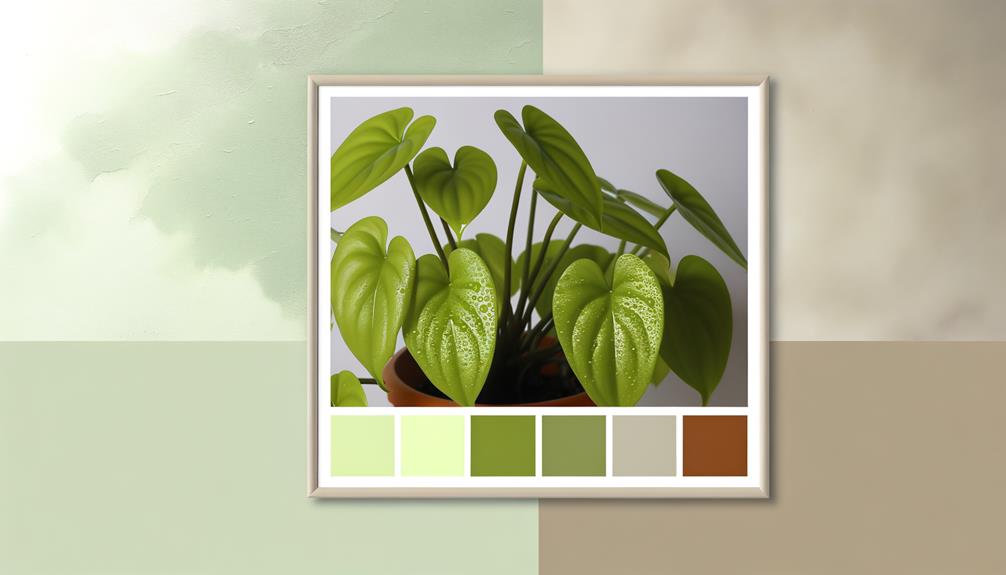
Proper watering is essential for Philodendron hederaceum var. kirkbridei, requiring a balanced regimen that avoids both overwatering and underwatering to maintain ideal soil moisture levels.
The substrate should be kept consistently moist but not soggy, as excessive waterlogging can lead to root rot (Pythium spp.) and other fungal infections. It is advisable to water when the top 1-2 inches of the soil feel dry to the touch. Employing well-draining soil, as previously discussed, guarantees that excess water does not accumulate around the root zone.
Seasonal adjustments are necessary; during the growing season (spring and summer), more frequent watering is needed, whereas in the dormant period (fall and winter), watering should be reduced to prevent water stress.
Light Preferences
In addition to precise watering, understanding the light preferences of Philodendron hederaceum var. kirkbridei is important for promoting ideal development and overall plant health. This species thrives in environments that mimic its native tropical habitats, requiring indirect, bright light to flourish. Direct sunlight can cause leaf burn, while insufficient light levels may result in leggy growth and diminished foliage color.
Here are the key light requirements for optimal development:
- Bright, Indirect Light: Mimics the forest canopy of its natural habitat.
- Avoid Direct Sunlight: Prevents leaf scorch and damage.
- Consistent Light Exposure: Guarantees balanced growth and health.
- Adaptable to Low Light: Can tolerate lower light conditions but will grow more slowly.
Temperature and Humidity
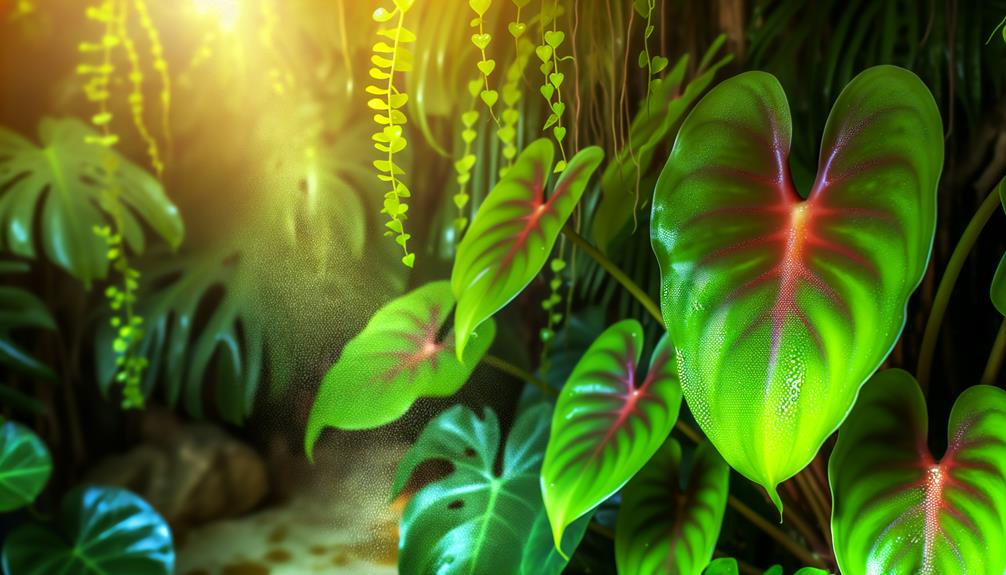
Philodendron hederaceum var. kirkbridei thrives within a temperature range of 18-24°C, ensuring best metabolic function and growth.
Relative humidity levels between 60-80% are imperative for maintaining turgor pressure and preventing desiccation of foliar tissues.
Deviations from these conditions can lead to physiological stress and increased susceptibility to pathogens.
Ideal Temperature Range
Understanding the best temperature and humidity conditions for Philodendron hederaceum var. kirkbridei is essential for ensuring its robust growth and overall health. This tropical species thrives in specific temperature ranges, which mimic its natural habitat.
- Optimal Temperature Range: Maintain daytime temperatures between 18°C to 27°C (64°F to 80°F) for ideal growth.
- Nighttime Temperature: Guarantee nighttime temperatures do not drop below 15°C (59°F) to avoid stress.
- Consistency: Aim for a stable temperature environment, as fluctuations can hinder physiological processes.
- Avoid Extremes: Temperatures above 30°C (86°F) or below 10¼ (50¿) can cause cellular damage and inhibit metabolic functions.
Humidity Requirements
Maintaining a relative moisture level between 60% and 80% is vital for the best growth of Philodendron hederaceum var. kirkbridei, as it closely mimics the plant's native tropical environment.
Elevated moisture levels facilitate optimal physiological processes such as transpiration and nutrient uptake. Inadequate moisture may lead to leaf desiccation and impaired growth.
Employing a humidifier or placing the plant on a tray with water and pebbles can sustain the necessary moisture levels. Additionally, regular foliar misting can provide short-term moisture boosts. Monitoring environmental conditions with a hygrometer ensures precise moisture control.
Understanding and implementing these moisture requirements is essential for cultivating a healthy Philodendron hederaceum var. kirkbridei in non-tropical indoor settings.
Common Pests and Diseases
In Philodendron hederaceum var. kirkbridei, common pests such as aphids (Aphididae), spider mites (Tetranychidae), and mealybugs (Pseudococcidae) can cause significant damage to foliage, while diseases like bacterial leaf spot (Xanthomonas campestris) and root rot (Pythium spp.) pose serious threats to plant health.
Effective management requires vigilance and appropriate intervention. Here are key strategies:
- Regular Inspection: Frequent monitoring helps detect early infestations or infections.
- Proper Watering: Avoid overwatering to prevent root rot.
- Isolation: Quarantine new or affected plants to prevent spread.
- Biological Controls: Use beneficial insects like ladybugs to combat pests naturally.
Implementing these measures guarantees the plant remains healthy and vibrant, reducing the impact of pests and diseases.
Propagation Techniques
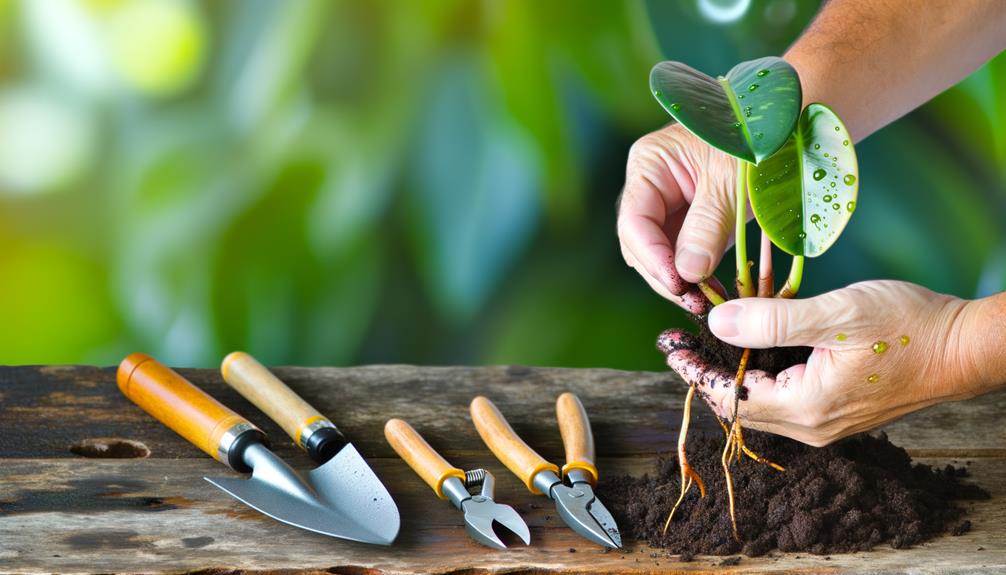
After addressing common pests and diseases, it is vital to explore effective propagation techniques to guarantee the proliferation and sustainability of Philodendron hederaceum var. kirkbridei. Propagation primarily involves stem cuttings, which should be taken from healthy, mature plants. Utilize a sterilized knife to make the cuts just below a node. The cuttings should then be placed in a water-filled container or directly into a well-draining soil mix. Ensuring best light and humidity conditions is essential for successful rooting.
| Step | Description | Notes |
|---|---|---|
| 1. Selection | Choose a healthy, mature stem | Free of pests/diseases |
| 2. Cutting | Make a cut below a node | Use sterilized tools |
| 3. Placement | Place in water/soil mix | Ensure drainage |
| 4. Conditions | Maintain high humidity and indirect light | Promote root growth |
| 5. Monitoring | Regularly check for root development and health | Adjust care as needed |
Styling and Display Tips
Arranging Philodendron hederaceum var. kirkbridei in aesthetically pleasing displays requires an understanding of its natural growth patterns and environmental preferences. This vining species thrives in indirect light and high humidity, necessitating careful placement to mimic its native habitat.
When styling, consider the following tips:
- Hanging Baskets: Utilize hanging baskets to allow the plant's vines to cascade naturally, showcasing its trailing habit.
- Trellises and Moss Poles: Train the vines to climb trellises or moss poles, promoting vertical growth and maximizing space.
- Shelf Displays: Place on shelves where the vines can drape elegantly, adding a lush, green touch to indoor spaces.
- Group Plantings: Combine with other tropical plants to create a visually cohesive and thriving micro-ecosystem.
These methods ensure ideal growth and visual appeal.
Conclusion
Philodendron hederaceum var. kirkbridei, with its intricate leaf patterns and adaptive growth habits, stands as a proof of the wonders of botanical diversity.
Its best growth is reminiscent of a well-tuned orchestra, where temperature, humidity, and care harmonize perfectly.
Despite vulnerability to common pests such as aphids and spider mites, successful propagation techniques guarantee its ongoing legacy.
This plant's unique aesthetic charm positions it as a focal point in both botanical collections and interior decor, much like a masterpiece in a grand gallery.

